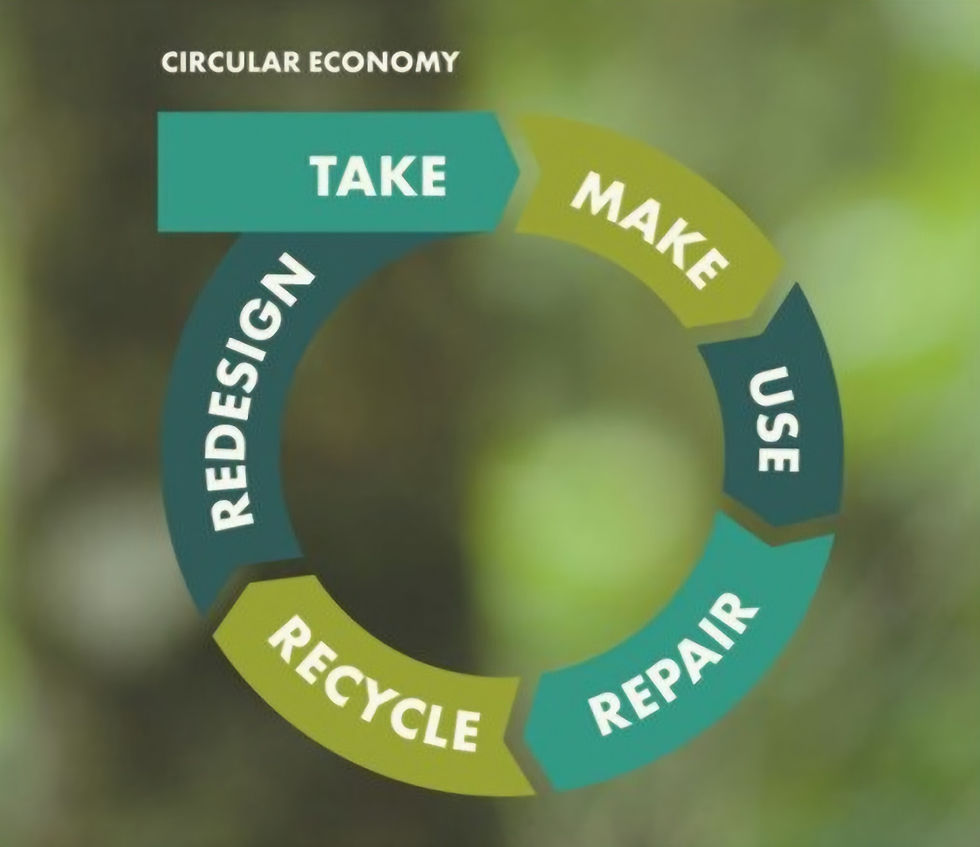#6 SUSTAINABILITY & RECYCLE: CIRCULAR, RECYCLING & LINEAR ECONOMY
- Food & Drinks Tips Team
- Feb 8, 2024
- 7 min read

Production models are organizational structures or systems that determine how goods or services are produced, distributed, and consumed. They describe the processes, methods, and practices used by a company or industry to transform inputs into finished products or provided services.
These models can vary widely depending on the sector, available technology, market needs, and organizational priorities. Some of tose models include: mass production, craft produtcion, just-in time production, lean production, and mass customization. Each production model can be shaped to align with the principles of either linear, recycling or circular economy.
LINEAR ECONOMY:

The linear economy model principles, also known as "take-make-dispose," began to develop during the Industrial Revolution in the 18th century. This model is characterized by the continuous extraction of raw materials from nature, followed by the production of goods that are consumed and eventually discarded as waste.
During the Industrial Revolution, there was a significant increase in mass production of goods, driven by mechanization and growing demand for manufactured products. This led to a mindset of large-scale production and unrestrained consumption, without consideration for the environmental impacts or the finite nature of natural resources. In this model, persists the idea that there are infinite natural resources and that the Earth has an infinite capacity for regeneration.
Over time, this linear production model became dominant in the global economy, driven by economic growth and profit-seeking. However, as the environmental impacts of excessive production and consumption became more evident, concerns about the sustainability of this model and its long-term effects on the environment and society.
These concerns gave rise to the concept of the recycling economy, which proposes a more sustainable approach to production and consumption, based on the reduction, reuse, and recycling of materials and products, in contrast to the linear model of "take-make-dispose." The transition to a recycling economy aims to minimize waste, conserve natural resources, and promote economic prosperity in a sustainable manner.
RECYCLING ECONOMY

The notion of a recycling economy began to gain prominence in the late 20th century as environmental concerns grew and awareness of the need to deal with waste and resources more efficiently became more evident. However, the term "recycling economy" is not as well-defined as the broader concept of a circular economy.
The recycling movement began to emerge in the 1960s and 1970s as concerns about pollution and resource depletion started to escalate. Recycling programs were implemented in various parts of the world, initially focusing on materials such as paper, glass, and metal. However, these early efforts were often limited and did not fully integrate the principles of a circular economy.
Here are some milestones and important figures who have given voice to recycling around the world:
Rachel Carson: While not specifically a recycling activist, Rachel Carson played a crucial role in raising environmental awareness with her book "Silent Spring", published in 1962. The book warned about the dangers of synthetic pesticides and helped drive the modern environmental movement.
Earth Day: The first Earth Day was celebrated on April 22, 1970, marking a significant turning point for the global environmental movement. The event was organized by U.S. Senator Gaylord Nelson and attracted millions of people worldwide, raising awareness about environmental issues, including the need for recycling and resource conservation.

Recycling Symbol: The international recycling symbol, composed of three arrows forming a loop, was designed in 1970 by Gary Anderson, a 23-year-old student at the University of Southern California. The symbol helped create a recognizable visual identity for the recycling movement.
Recycling Legislation: Throughout the 1960s and 1970s, various laws and regulations were enacted in different countries to promote recycling and waste management. For example, in 1976, the United States enacted the Resource Conservation and Recovery Act, which set goals for waste reduction and promoted recycling and proper management of hazardous waste.
Chico Mendes: While primarily known for his advocacy for the protection of the Amazon rainforest and the rights of indigenous people, Chico Mendes also promoted sustainable land use practices that included responsible waste management and recycling initiatives.
Homero Aridjis: A prominent Mexican poet, novelist, and environmental activist, he has been a vocal advocate for environmental conservation and sustainability in Mexico. He has worked on various initiatives to protect biodiversity and promote recycling and waste reduction.
Chandi Prasad Bhatt: A renowned environmentalist and social activist in India, he is best known for his pioneering work in the Chipko movement, a grassroots environmental movement focused on forest conservation. While not specifically focused on recycling, his efforts have contributed to raising awareness about the importance of sustainable resource management.

Wangari Maathai: a Nobel laureate, political activist who founded the Green Belt Movement, a pioneering environmental organization that empowers communities, particularly women, through tree planting initiatives aimed at restoring degraded ecosystems, combating desertification, and promoting sustainable development. With a focus on grassroots activism, environmental education, and gender equality, the movement has made significant contributions to conservation efforts, local livelihoods, and global environmental awareness. Wangari Maathai's leadership and the Green Belt Movement's impact have inspired similar initiatives worldwide, making it a beacon of hope for positive change in environmental conservation and social justice.
Ian Kiernan: the founder of Clean Up Australia, an organization that coordinates community clean-up events to tackle litter and waste. Through his advocacy and activism, Kiernan raised awareness about the importance of waste reduction, recycling, and environmental stewardship in Australia.
Dame Ellen MacArthur: a former professional sailor from the United Kingdom, Ellen MacArthur is now a prominent advocate for the circular economy. She established the Ellen MacArthur Foundation, which works to accelerate the transition to a circular economy by collaborating with businesses, governments, and academia worldwide.
It was only later, especially in the late 20th and early 21st centuries, that the concept of a circular economy began to gain more prominence. The circular economy expands the approach of recycling to include not only material recovery but also reuse, remanufacturing, sustainable product design, and consideration of the systemic aspects of production and consumption.
So, while the idea of a recycling economy began to develop in the 20th century, the circular economy, with its more comprehensive and holistic approach, is a more recent and advanced concept that has gained more attention in recent decades.
CIRCULAR ECONOMY

The circular economy model principles are an economic model based on the reduction, reuse, recovery, and recycling of materials and products to minimize waste and promote resource efficiency. It operates differently from the traditional linear model of "take, make, dispose," as it aims to keep materials in use for as long as possible, extract maximum value from them, and regenerate natural systems.
In this model, products are designed to be durable, repairable, and recyclable, and materials are recovered and reintroduced into the production chain whenever possible. This involves closing material loops through recycling, composting, and other forms of resource recovery. Additionally, the circular economy encourages the shift to service-based business models, where products are leased, shared, or refurbished rather than sold as property.
At the core of the circular economy is the concept of zero waste, where waste is eliminated, and resources are used efficiently and sustainably. This not only benefits the environment by reducing pressure on natural resources and minimizing pollution but also brings economic opportunities such as job creation in the recycling industry and innovation in new technologies and sustainable materials. In summary, the circular economy aims to create a regenerative and resilient system that benefits both people and the planet.
It's clear that the recycling economy paved the way for the circular economy, and in a sense, they are interconnected, but there are some differences between them. While the recycling economy primarily focuses on reprocessing materials into new products to reduce waste and conserve resources, the circular economy takes a more comprehensive approach. It aims to design products and systems with longevity, repairability, and recyclability in mind, creating closed-loop systems where resources are continuously reused. The circular economy goes beyond just recycling by considering the entire lifecycle of products and optimizing resource use at every stage, ultimately aiming for economic, environmental, and social benefits beyond waste reduction alone.
Examples of economy in different types of production:
Mass Production: Characterized by the large-scale production of a single standardized product, often using assembly lines and efficient production technologies. This model is commonly associated with the Industrial Revolution and the mass production of consumer goods. Historically, mass production has often been associated with the linear economy, where resources are extracted, transformed into products, and eventually disposed of after use. However, recycling and reuse practices can be incorporated into mass production to make it more circular. For example, companies can implement recycling programs for waste generated during production or develop products that can be easily disassembled and recycled at the end of their life cycle.
Craft Production: Involves the manufacturing of custom-made or personalized products, often using traditional methods and manual skills. This model values quality, attention to detail, and the uniqueness of products. Craft production typically fits better within a circular economy, as it values durability, quality, and uniqueness of products, often resulting in a more sustainable approach. But this type of production can promote the circular economy by emphasizing repair, reuse, and product longevity, thereby avoiding premature disposal.
Just-in-Time Production: Based on demand-driven production, where products are manufactured only when they are requested by customers, minimizing inventory and reducing waste. This model is commonly used in the automotive industry and other manufacturing industries. Just-in-time production can be linear if there is no emphasis on material reuse or waste minimization throughout the production process. However, just-in-time production can be adapted to align with circular economy principles, for example, through the recovery and reuse of by-products or recycling of materials discarded during the manufacturing process.
Lean Production: Similar to just-in-time, lean production seeks to eliminate waste and maximize efficiency in all aspects of production, including materials, time, and labor. This model emphasizes continuous improvement and employee involvement in the production process. Similarly, lean production can be linear if there is no consideration for waste minimization or resource reuse. However, lean production principles can be applied to promote circularity by optimizing processes and eliminating waste throughout the production chain.
Mass Customization: Combines elements of mass production and craft production, allowing for the efficient production of a variety of customized products to meet individual customer needs. Mass customization may follow a linear approach if there are no efforts to minimize waste or extend the lifespan of customized products. But, by designing customized products with an emphasis on durability, reparability, and material reuse, mass customization can be adapted to promote a circular economy.
Comments